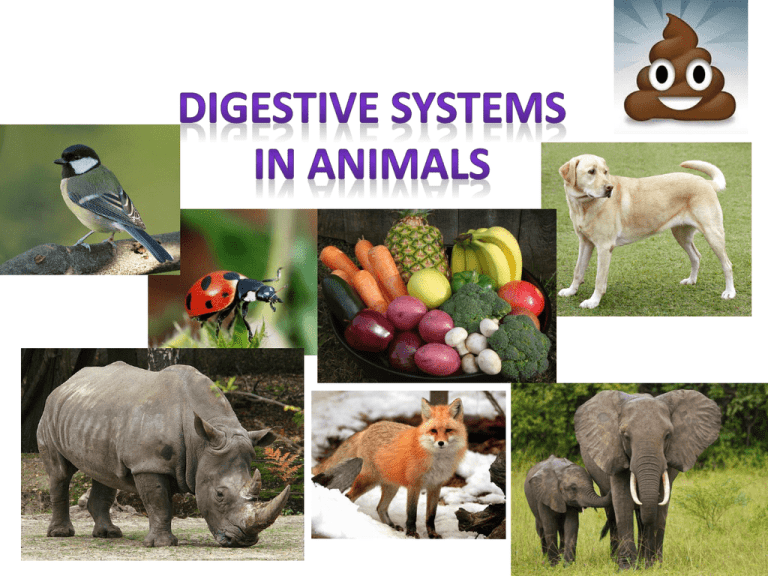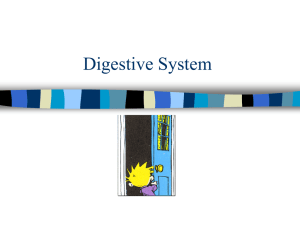Digestive Systems in Animals
advertisement

-Heterotrophs cannot produce their own food and must consume other organisms to obtain energyyielding food - animals use a wide variety of processes and behaviours to search for, process, and take in their food Feeding Mechanisms -Despite different shapes, sizes, and diets, ALL animals obtain food through one of the four feeding mechanisms - the feeding device (ex. Mouth) can usually tell you what kind of a feeder an organism is Feeding Mechanisms 1. Filter Feeders - aquatic animals - use a filtering body structure to gather organisms in surrounding water - feeder siphons water into mouth and filters out small organisms to digest (ex. protists, bacteria, larvae) Eg. Tube sponge, flamingos, clams, barnacles, whales Feeding Mechanisms 2. Substrate Feeders -Live in or on their food source and eat their way through it Eg. Caterpillars (eat through tissues of leaves), worms (ingest soil particles with decayed material as they go) Feeding Mechanisms 3. Fluid Feeders -Suck or lick nutrient-rich fluids from live plants or animals - mouth parts are adapted to pierce or rip skin or leaf tissue - mouth parts suck or lick blood or sap in their food Eg. Mosquitoes, ticks, aphids, spiders, bees, butterflies, hummingbirds, vampire bats Feeding Mechanisms 4. Bulk Feeders -Includes most vertebrates - ingest fairly large pieces of food and sometimes swallow it whole - can use tentacles, pincers, claws, fangs, jaws, or teeth to kill, tear pieces off, or take in mouthfuls of their food Eg. Humans, great blue heron Stages of Food Processing -Nutrients from food must get into individual cells of an animal’s body in a usable form - the essential function of an animal’s digestive system is to break food down into small, soluble pieces that can pass through cell membranes - food is broken down into useful substances that can be absorbed into the circulatory system, and transported to individual cells Stages of Food Processing There are four stages of digesting food: 1) Ingestion – Food is taken in or eaten. 2) Digestion – Food is broken down by mechanical and chemical processes into molecules small enough for the body to absorb. 3) Absorption – Products of digestion are transported from the digestive system into the circulatory system. The circulatory system the distributes the products to the rest of the body. 4) Elimination – Undigested solid waste matter is removed from the body. Alimentary Canal - a digestive tract consisting of a long open tube, with a mouth on one end to ingest food, and an anus on the other end to eliminate waste - Processes food as it moves along the canal with different organs - AKA the Digestive Tract Eathworms have very simple digestive tracts. Gastrovascular Cavity Feeding Simple organisms like hydra have a sac-like digestive system, called grastrovascular systems. • their mouth and anus are the same. • pouch lined with digestive cells that secrete enzymes • does not allow for a digestive stages of a tube • less efficient, quicker. Eg. Flatworms, jellyfish QuickTime™ and a decompressor are needed to see this picture. Cellular Digestion -used by simple organisms -Cells engulf food and allow it to penetrate membrane - can be stored in vacuole or used for energy right away - food is broken down by enzymes that the cell releases











